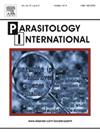尼日利亚奥约州伊巴丹市奥纳阿拉市大规模药物管理期间与土壤传播蠕虫有关的露天排便和卫生习惯
IF 1.9
4区 医学
Q3 PARASITOLOGY
引用次数: 0
摘要
土壤传播蠕虫(STHs)感染是热带非洲被忽视的热带病(NTDs)之一,已成为2030年可能消除的目标。该研究于2022年8月至2023年7月在尼日利亚伊巴丹的Ona-Ara地方政府区(LGA)进行,旨在调查在社区大规模给药时期露天排便(OD)、水、环境卫生和个人卫生(WASH)做法对STHs状况的影响。向同意的参与者发放了450份结构化问卷,涵盖人口统计学(年龄、性别)和WASH实践。从LGA的Akanran、Olorunda、idii - ose、Amuloko和Ore-Meji五个不同社区收集了450份同意参与者的粪便样本和1350份环境土壤样本。采用浮法和改进的Baermann法从污染土壤中提取寄生虫,采用沉淀法检测粪便样品中的寄生虫,并采用Kato-Katz技术定量。数据分析采用描述性、回归和方差分析,α 0.05。59.8%的参与者没有获得饮用水,40.2%的人直接从水龙头获得饮用水。此外,有42.2%设有抽水马桶,41.1%设有坑厕,16.7%设有口服药物,其中60.8%感染了STH。在卫生习惯方面,6.7%表示便后不用肥皂和水洗手,43.8%则表示偶尔使用纸巾或水。在奥纳阿拉,从参与者收集的粪便样本中寄生虫的流行率为38%,总体强度为每克粪便265种。蛔虫的STH强度最高(300epg),其次是钩虫(210epg),滴虫(50epg),蛔虫最低(32epg)。寄生虫分布差异有统计学意义,χ2 = 75.21, p≤0.05。52.1%的土壤中至少有一种STH寄生虫,其中阿坎兰(35.8%)、奥洛伦达(37.8%)、阿穆洛科(39.4%)和伊德-奥斯(59.3%)的土壤样本中蛔虫幼虫的感染率最高,Ore-Meji的钩虫幼虫的感染率最高,为60.7%。由于吸毒过量和卫生习惯,STH在奥纳阿拉的居民和土壤环境中不断传播。应在社区中进一步开展一种健康方法(动物、环境和人)研究。本文章由计算机程序翻译,如有差异,请以英文原文为准。
Open defaecation and hygiene practices in relation to Soil-Transmitted Helminths in the advent of Mass Drug Administration in Ona-Ara, Ibadan, Oyo State, Nigeria
Soil-Transmitted Helminths (STHs) infections are one of the Neglected Tropical Diseases (NTDs) in tropical Africa and have been targeted for possible elimination in the year 2030. This study was conducted between August 2022 and July 2023 in Ona-Ara Local Government Area (LGA), Ibadan, Nigeria, to investigate the effects of Open Defaecation (OD), Water, Sanitation, and Hygiene (WASH) practices on STHs status in the advent of mass drug administration in the communities. 450 structured questionnaires covering demographics (age, sex), and WASH practices were given to consenting participants. 450 faecal samples from consenting participants and 1350 soil samples from the environment were collected from five different communities: Akanran, Olorunda, Idi-Ose, Amuloko, and Ore-Meji in the LGA. Parasites were extracted from the contaminated soil using floatation and modified Baermann methods while sedimentation method was used to detect parasites in the faecal samples and quantified by Kato-Katz techniques. Data were analyzed using descriptive, regression and ANOVA at α 0.05. 59.8 % of the participants did not have access to potable water while 40.2 % claimed drinking water directly from the tap. Furthermore, 42.2 % had water closet, 41.1 % pit latrine, and 16.7 % practised OD of which 60.8 % are infected with STH. In terms of hygiene practices, 6.7 % reported that they do not wash with soap and water after defaecation, while 43.8 % claimed that they use tissue paper or water occasionally. The parasites prevalence in faecal samples collected from participants was 38 % in Ona Ara and the overall intensity was 265 per gram of faeces. Ascaris had the highest intensity of STH (300epg), followed by hookworm (210epg), Trichuris (50epg), and the least Strongyloides (32epg). The variation in the distribution of parasites was significant at χ2 = 75.21, p ≤ 0.05. 52.1 % of the sampled soil had at least one STH parasites and Strongyloides larvae was found to have highest prevalence in soil samples collected in the following locations: Akanran (35.8 %), Olorunda (37.8 %), Amuloko (39.4 %), and Idi-Ose (59.3 %) whereas, hookworm larvae had highest prevalence of 60.7 % in Ore-Meji. There is continuous transmission of STH among the populations living in Ona-Ara and the soil environment owing to OD and the hygiene practices. One Health Approach (animal, environment, and man) studies should be further carried out in the communities.
求助全文
通过发布文献求助,成功后即可免费获取论文全文。
去求助
来源期刊

Parasitology International
医学-寄生虫学
CiteScore
4.00
自引率
10.50%
发文量
140
审稿时长
61 days
期刊介绍:
Parasitology International provides a medium for rapid, carefully reviewed publications in the field of human and animal parasitology. Original papers, rapid communications, and original case reports from all geographical areas and covering all parasitological disciplines, including structure, immunology, cell biology, biochemistry, molecular biology, and systematics, may be submitted. Reviews on recent developments are invited regularly, but suggestions in this respect are welcome. Letters to the Editor commenting on any aspect of the Journal are also welcome.
 求助内容:
求助内容: 应助结果提醒方式:
应助结果提醒方式:


